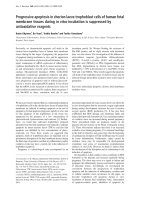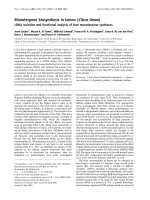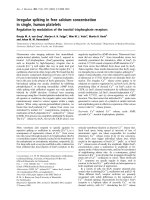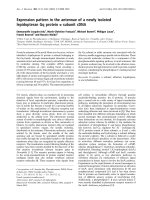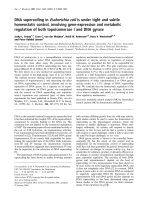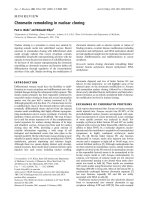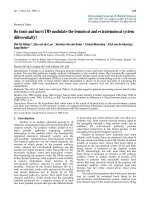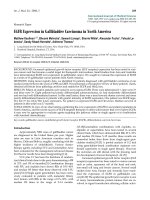Báo cáo y học: "Do changes in pulse oximeter oxygen saturation predict equivalent changes in arterial oxygen saturation" pdf
Bạn đang xem bản rút gọn của tài liệu. Xem và tải ngay bản đầy đủ của tài liệu tại đây (115.65 KB, 5 trang )
Available online />Research
Do changes in pulse oximeter oxygen saturation predict
equivalent changes in arterial oxygen saturation?
Gavin D Perkins
1
, Daniel F McAuley
2
, Simon Giles
3
, Helen Routledge
4
and Fang Gao
5
1
Specialist Registrar, Intensive Care Unit, Birmingham Heartlands and Solihull NHS Trust (Teaching), Birmingham Heartlands Hospital, Birmingham, UK
2
Specialist Registrar, Intensive Care Unit, Birmingham Heartlands and Solihull NHS Trust (Teaching), Birmingham Heartlands Hospital, Birmingham, UK
3
Nurse Consultant, Intensive Care Unit, Birmingham Heartlands and Solihull NHS Trust (Teaching), Birmingham Heartlands Hospital, Birmingham, UK
4
Specialist Registrar, Intensive Care Unit, Birmingham Heartlands and Solihull NHS Trust (Teaching), Birmingham Heartlands Hospital, Birmingham, UK
5
Consultant in Anaesthesia and Intensive Care Medicine, Intensive Care Unit, Birmingham Heartlands and Solihull NHS Trust (Teaching), Birmingham
Heartlands Hospital, Birmingham, UK
Correspondence: F Gao,
Introduction
Pulse oximetry is used almost universally in the management
of critically ill patients in the intensive care unit (ICU) and oper-
ating theatre [1]. Its uses include the detection of hypoxia [1],
avoidance of hyperoxia [2], reduction in the frequency of blood
gas analysis [3], titration of fractional inspired oxygen [4] and
for weaning from mechanical ventilation [5].
An arterial oxygen saturation (Sa
O
2
) of 90% has been proposed
as a target for adequate oxygenation during mechanical
ventilation [5]. Previous studies investigating the use of pulse
oximeter oxygen saturation (Sp
O
2
) in intensive care patients
have reported that the minimum Sp
O
2
levels to maintain SaO
2
at 90% range between 92% and 96% [4,6,7]. However, these
studies have not answered the question of whether, after
achieving a target Sa
O
2
, a subsequent change in SpO
2
pre-
dicts a corresponding change in Sa
O
2
in the critically ill.
Some studies have reported that anaemia reduces the preci-
sion of pulse oximetry [8] by increasing the signal to noise
ratio with low haemoglobin concentrations, whereas others
failed to demonstrate this phenomenon [9,10]. Acidosis may
R67
ICU = intensive care unit; Sa
O
2
= arterial oxygen saturation; SD = standard deviation; Sp
O
2
= pulse oximeter oxygen saturation.
Abstract
Introduction This study investigates the relation between changes in pulse oximeter oxygen saturation
(Sp
O
2
) and changes in arterial oxygen saturation (Sa
O
2
) in the critically ill, and the effects of acidosis
and anaemia on precision of using pulse oximetry to predict Sa
O
2
.
Patients and methods Forty-one consecutive patients were recruited from a nine-bed general
intensive care unit into a 2-month study. Patients with significant jaundice (bilirubin >40 µmol/l) or
inadequate pulse oximetry tracing were excluded.
Results A total of 1085 paired readings demonstrated only moderate correlation (r = 0.606; P < 0.01)
between changes in Sp
O
2
and those in SaO
2
, and the pulse oximeter tended to overestimate actual
changes in Sa
O
2
. Anaemia increased the degree of positive bias whereas acidosis reduced it.
However, the magnitude of these changes was small.
Conclusion Changes in Sp
O
2
do not reliably predict equivalent changes in SaO
2
in the critically ill. Neither
anaemia nor acidosis alters the relation between Sp
O
2
and SaO
2
to any clinically important extent.
Keywords acidosis, anaemia, arterial oxygen saturation, critical care, pulse oximetry
Received: 23 September 2002
Revisions requested: 2 December 2002
Revisions received: 10 December 2002
Revisions requested: 25 February 2003
Revisions received: 29 March 2003
Accepted: 12 May 2003
Published: 11 June 2003
Critical Care 2003, 7:R67-R71 (DOI 10.1186/cc2339)
This article is online at />© 2003 Perkins et al., licensee BioMed Central Ltd
(Print ISSN 1364-8535; Online ISSN 1466-609X). This is an Open
Access article: verbatim copying and redistribution of this article are
permitted in all media for any purpose, provided this notice is
preserved along with the article's original URL.
Open Access
R68
Critical Care August 2003 Vol 7 No 4 Perkins et al.
also influence the relation between Sp
O
2
and Sa
O
2
. The
in vitro method employed by the carbon monoxide (CO)-
oximeter requires red blood cell lysis, whereas the pulse
oximeter analyzes haemoglobin in whole blood [11]. The dif-
ference between intracellular and extracellular hydrogen ion
concentrations under normal physiological conditions has
been incorporated into the pulse oximeter algorithms.
However, the robustness of this adjustment has not been
evaluated in the critically ill and acidotic patient.
We therefore conducted a prospective observational study to
test the hypothesis that a change in Sp
O
2
would predict an
equivalent change in Sa
O
2
. Such a relation, if it exists, would be
invaluable in deciding when to titrate fractional inspired oxygen
and/or repeat arterial blood gases in the individual patient. Fur-
thermore, we examined the effects of anaemia and acidosis on
the precision of using the pulse oximeter to predict the Sa
O
2
in
a heterogeneous group of critically ill patients.
Patients and methods
This study was considered by the local research and ethics
committee and the need for informed consent was waived in
view of the observational nature of the study.
During a 2-month period all patients admitted to our ICU who
had an arterial line for the measurement of blood gases and
who were being monitored by continuous pulse oximetry
were recruited. The following patients were excluded: those
with significant jaundice (bilirubin >40 µmol/l) or a history of
smoke inhalation; those with an inadequate Sp
O
2
trace (as
determined by visual analysis of a flat, absent, or irregular
signal waveform); and those in whom fewer than two arterial
blood gas readings were taken.
Serial arterial blood gas samples were taken after 5 ml blood
had been discarded when indicated as part of routine clinical
care. No samples were taken solely for the study nor was any
attempt made to vary inspired oxygen concentration or
mechanical ventilation for the purposes of the study. The
samples were analyzed in a standardized manner within 2 min
of sampling. Arterial blood gas samples were analyzed using a
CO-oximeter (ABL 725, Radiometer, Copenhagen, Denmark)
that was calibrated daily by laboratory staff and has a 2-hourly
automatic internal calibration sequence. Haemoglobin concen-
tration (g/dl), hydrogen ion concentration (nmol/l), and per-
centage Sa
O
2
were recorded for each sample. Precision and
accuracy of a whole blood sample for Sa
O
2
, hydrogen ion con-
centration and haemoglobin concentration are 0.3 and 0%,
0.034 and 0.008 nmol/l, and 0.12 and 0.4g/dl, respectively,
within a haemoglobin range of 5–20 g/dl.
Pulse oximetry readings were recorded simultaneously with
blood gas sampling using a Nellcor (Puritan Bennett,
Pleasanton, NJ, USA) finger probe attached to a Hewlett
Packard (Palo Alto, CA, USA) Merlin monitor. The pulse
oximeter displays an average Sp
O
2
from the preceding 5-s
beat by beat analysis. The measurements between healthy
individuals (n = 12) had a coefficient of variation of 0.4% at a
SpO
2
of 97%. Probes were attached to a finger, choosing
the digit that gave the best trace and but not necessarily on
the arm from which the arterial blood gas sample was drawn.
However, the same probe was used for all measurements
from the same patient.
Statistical analysis
Data were stored using Microsoft Excel 97 and analyzed
using SigmaStat for Windows 95 (SPSS Inc. Chicago, IL,
USA) and GLIM (Generalized Linear Interactive Modeling)
version 4, update 8 (Royal Statistical Society, London, UK),
running on a DEC Alpha AXP mainframe computer under the
Ultirx operating system (OSF/1). The changes in residuals
were tested for normality and found to be normally distrib-
uted. The linear relations between differences in two succes-
sive measurements of Sp
O
2
and SaO
2
in all patients were
analyzed using Pearson correlation coefficient (r), linear
regression and goodness-of-fit (adjusted R
2
). The variations
between and within the patients were examined using com-
parisons of the residual standard deviations (SDs) between a
single line from a common slope through all the changes for
all 41 patients and a separate line to each patient.
The effects of anaemia and acidosis on the agreement
between the two measurement techniques were examined
using a Bland–Altman plot [12] in which the difference
between Sp
O
2
and SaO
2
was plotted against their average
[13]. Bias and the limits of agreement were calculated. Bias
was calculated as the mean of the differences between the
CO-oximeter and pulse oximeter readings (Sa
O
2
–SpO
2
) [11].
Positive bias indicated that the pulse oximeter underesti-
mated the Sa
O
2
, whereas negative bias indicated that the
pulse oximeter was overestimating the Sa
O
2
. The limits of
agreement were taken as the bias ± (1.96 × SD) [6,13].
Approximately 95% of data fell within the haemoglobin concen-
tration range 8–11.9g/dl and the hydrogen ion concentration
range 25–62.9nmol/l (pH7.2–7.6). Therefore, haemoglobin
concentrations ≤7.9 or ≥12g/dl or hydrogen ion concentra-
tions ≥63nmol/l were regarded in the study as extremes. The
differences of biases between these three groups were ana-
lyzed using one-way, repeated measure analysis of variance.
P≤0.05 was considered statistically significant.
Results
Forty-one (22 male) patients (age [mean ± SD] 70 ± 14 years)
were recruited into the study. A total of 1132 simultaneous
arterial blood gas and pulse oximeter readings were taken
(mean [range] 27 [3–91] readings per patient). Sequential
readings in each patient were grouped together into pairs,
which gave 1085 paired readings (47 readings were
excluded because they were either not paired or unidentifi-
able to a particular patient, or the patient had fewer than two
readings taken). These data were analyzed to determine the
R69
relation between changes in SpO
2
(∆SpO
2
) and changes in
Sa
O
2
(∆SaO
2
).
The mean ± SD for Sp
O
2
was 94.6 ± 2.7% and the mean
for Sao
2
was 95.9 ± 2.4%. In terms of predicting ∆Sao
2
from ∆Spo
2
, fitting a single line from all the 41 patients,
gives a residual SD of 1.303 and fitting a separate line to
each patient gives a residual SD of 1.288 (P = 0.999).
Therefore, there was no significant difference in residual
SD within patients overall. Although we found moderate
correlation between ∆Sp
O
2
and ∆SaO
2
(r = 0.606;
P < 0.01; Fig. 1), only 36.7% of the variation in this relation
was due to the association of changes in Sp
O
2
with
changes in Sa
O
2
(adjusted R
2
= 0.367). The prediction of
∆Sa
O
2
from ∆SpO
2
(∆SaO
2
= 0.003 + 0.477∆SpO
2
) demon-
strates that the pulse oximeter overestimates actual
changes in Sa
O
2
.
The 1085 simultaneous arterial blood gas and pulse oximeter
readings from the 41 patients were analyzed to determine the
effects of anaemia and acidosis on bias and limits of agree-
ment. For the data altogether, the bias was 1.34 and the
limits of agreement were –2.29 and +4.97 (Fig. 2). There
were only small changes in bias with anaemia (+2.09) and
acidosis (+0.38), as shown in Table 1. The difference in bias
between hydrogen ion concentrations of 25–63 nmol/l and
≥63 nmol/l (P < 0.01), and between haemoglobin concentra-
tions of <8 g/dl, 8–11.9 g/dl and >12 g/dl (P < 0.01) all
achieved statistical significance. The bias was not signifi-
cantly different between haemoglobin concentrations of
<7.9 g/dl and 8–11.9 g/dl (P = 0.24). There were insufficient
numbers in the group with hydrogen ion concentration
<24.9 nmol/l (n = 10) for analysis to be done.
Discussion
The present study shows that changes in SpO
2
do not reliably
predict equivalent changes in Sa
O
2
, with the pulse oximeter
tending to overestimate actual changes in Sa
O
2
. We also
showed that Sp
O
2
underestimates SaO
2
to a greater extent
with progressive anaemia, whereas acidosis increases the
Sp
O
2
estimate of SaO
2
. However, the clinical significance of
these changes is small.
Available online />Figure 1
Linear relations between changes in pulse oximeter oxygen saturation
(Sp
O
2
) and arterial oxygen saturation (Sa
O
2
).
–10.0
–8.0
–6.0
–4.0
–2.0
0.0
2.0
4.0
6.0
8.0
10.0
–10.0
–8.0 –6.0 –4.0 –2.0 0.0 2.0 4.0 6.0 8.0 10.0
Change in SaO
2
Change in SpO
2
r = 0.606; Adjusted R
2
= 0.367; P < 0.01
Figure 2
Bland and Altman plot for bias and limits of agreement for total data.
Sa
O
2
, arterial oxygen saturation; Sp
O
2
, pulse oximeter oxygen
saturation.
–10
–8
–6
–4
–2
0
2
4
6
8
10
80 90 100
(Sa
O
2
+ SpO
2
) / 2 %
(SaO
2
– SpO
2
)%
Upper limit of
agreement
Lower limit of
a
greemen
t
Bias
Table 1
The effects of anaemia and acidosis on bias and limits of agreement
Haemoglobin concentration (g/dl) Hydrogen ion concentration (nmol/l)
Total <8 8–12 >12 25–63 >63
n (measurements) 1132 49 963 120 1064 58
Bias 1.34 2.09* 1.37* 0.72
†‡
1.39 0.38
§
Upper limit 4.97 7.04 4.87 4.37 4.95 4.61
Lower limit –2.29 –2.79 –2.14 –2.93 –2.18 –3.85
P < 0.01, versus *haemoglobin >12 g/dl,
†
haemoglobin <8 g/dl,
‡
haemoglobin 8–12 g/dl and
§
hydrogen 25–63 nmol/l.
R70
The titration of fractional inspired oxygen during weaning from
mechanical ventilation is frequently adjusted with the goal of
maintaining a target Sp
O
2
value. Jubran and Tobin [4], in a
study involving 54 ICU patients, reported that levels of Sp
O
2
of 92% in white patients and 95% in black patients main-
tained arterial oxygen tension at 8 kPa or greater in 92% and
85% of patients, respectively. Seguin and coworkers [6]
defined a minimum Sp
O
2
of 96% to ensure that no patients
had a Sa
O
2
below 90%. This approach avoided hypoxia, but
15% of patients had a Sa
O
2
of 98% or greater.
Although target values can be helpful, it would be valuable to
know whether a change in Sp
O
2
would predict a similar
change in Sa
O
2
in critically ill patients over time. Hypotheti-
cally, the relatively static patient factors that interfere with
pulse oximetry (skin colour, finger size, carboxyhaemoglobin,
methaemoglobin) do not change, and so the correlation
between changes in Sa
O
2
and SpO
2
might be expected to be
closer than that between absolute values from a mixed patient
population. This could allow individualized target Sp
O
2
to be
set, based on a single, one-off Sa
O
2
reading. Only one small
study has attempted to address this question in the intensive
care setting. In a series of 45 patients (135 measurements),
Van de Louw and coworkers [14] recently reported that
changes in Sp
O
2
could not accurately predict changes in
Sa
O
2
. Our larger study supports and extends this early
finding. The prediction of ∆Sa
O
2
from ∆Sp
O
2
(∆SaO
2
= 0.003 + 0.477∆SpO
2
) demonstrates that, on
average, the pulse oximeter overestimates actual changes in
Sa
O
2
. This suggests that a similar degree of caution is
required in interpreting changes in pulse oximetry in the criti-
cally ill as in one-off readings.
Progressive reductions in haemoglobin concentration may
reduce the precision of the pulse oximeter as the
signal : noise ratio from surrounding tissue increases [15].
Early studies examining the effects of anaemia on the preci-
sion of the pulse oximeter found reduced precision in associ-
ation with anaemia. Lee and coworkers [8] demonstrated a
deterioration in bias and precision in dogs with a haematocrit
below 10%, and Severinghaus and coworkers [16] reported
increased error in anaemic humans when the Sa
O
2
was less
than 75%. In contrast, case reports have described cases in
which the pulse oximeter remained precise at haemoglobin
concentrations of 2.7 g/dl [17] and 3.0 g/dl [10]. A subse-
quent case series of 17 patients with acute anaemia due to
haemorrhage (haemoglobin concentration 2.3–8.7 g/dl) did
not detect any deterioration in the accuracy of measurements
using the pulse oximeter in the absence of hypoxia [9]. Our
study did not include sufficient numbers with hypoxia (Sp
O
2
<90%) for the influence of anaemia on bias and precision to
be studied in this patient group. However, under normal phys-
iological conditions (Sp
O
2
>90%) our results support and
extend previous findings in demonstrating that anaemia has
only a minor impact on the precision of measurements using
the pulse oximeter.
Our data show that, in the presence of acidosis, the degree to
which Sp
O
2
underestimates SaO
2
was reduced. One possible
explanation for this finding may relate to the differences in the
techniques used for measuring oxygen saturation. The pulse
oximeter analyzes haemoglobin saturation in whole blood in
vivo [18], whereas Sa
O
2
measured by CO-oximetry requires
red blood cell lysis prior to analysis. Under normal physiologi-
cal conditions, algorithms incorporated in the pulse oximeter
account for this [11], although the validity of this adjustment
has not been tested outside normal physiological ranges.
Alternatively, the effects of the complex interactions between
cardiac output [19], systemic vascular resistance [20], tem-
perature [19] and vasoactive drugs [14,21] on precision of
measurements using the pulse oximeter might have con-
tributed to this finding. A further study looking at the precise
contribution of each of these factors would be required to elu-
cidate the aetiology of these findings definitively.
There are several potential confounding variables that were
not controlled for in the study design. First, like in other
studies [4,6], we did not analyze the influence of carboxy-
haemoglobin and methaemoglobin concentrations on bias
and precision. The pulse oximeter is unable to distinguish
between these two forms of haemoglobin and oxyhaemoglo-
bin, leading it to overestimate the actual Sa
O
2
if significant
concentrations of either are present [22,23]. We excluded
patients with a history of smoke inhalation, in whom carboxy-
haemoglobin levels may be high. In nonsmokers carboxy-
haemoglobin levels are normally less than 2% and
methaemoglobin levels are less than 1% [15] – levels that are
already accounted for by the built-in algorithms of pulse
oximeters. In cigarette smokers carboxyhaemoglobin is ini-
tially elevated (average 4.78%) but falls over time (half life
5–6 hours) [24]. The clearance of carboxyhaemoglobin is
also accelerated by ventilation [25]. Because most patients
had been ventilated for several hours before entry into the
study, this is unlikely to have significantly confounded the
results. We excluded patients with significant jaundice – a
group known to have high carboxyhaemoglobin levels [26] –
in order to minimize this potential error, and no patients were
admitted following smoke inhalation during the study period.
Anaemia and acidosis have not been found to influence car-
boxyhaemoglobin or methaemoglobin concentrations.
Although we believe that the influence of carboxyhaemoglo-
bin levels in the study was minimal, we are unable to rule it
out as a potential confounding variable.
Second, we did not classify patients according to skin colour
or race, which may impact on accuracy of the pulse oximeter
[4]. Because skin colour is constant, comparisons of changes
in Sp
O
2
are unlikely to have been affected. Data for the
assessments for bias and precision caused at the extremes of
anaemia and acidosis were collected from 19 and
14 patients, respectively, and there did not appear to be any
systematic difference in the groups’ racial composition from
that in the overall study population. No patients to our knowl-
Critical Care August 2003 Vol 7 No 4 Perkins et al.
R71
edge had sickle cell anaemia/trait [17], although this was not
specifically tested for.
Third, the mean Sp
O
2
reading for the total data was 94.6%,
with a corresponding Sa
O
2
value of 95.9%. This is consistent
with previous investigators’ recommendations for minimal
target values for Sp
O
2
during mechanical ventilation. However,
less than 5% of data fell in the range of SpO
2
levels below
90%. Fig. 2 shows increasing positive bias and greater varia-
tion as saturations fall. This is consistent with a worsening of
bias and precision with pulse oximetry when the Sa
O
2
is less
than 90% [14]. At lower saturations the effects of anaemia
and acidosis may become more prominent, and our results
should therefore be applied with caution in this situation.
Finally, the pulse oximeter presents Sp
O
2
data as integers
whereas the CO-oximeter presents Sa
O
2
data to 1 decimal
place. With over 1000 data points, it is likely that the oximeter
rounded up and rounded down a similar number of times, and
so these differences will most likely cancel each other out. At
most, the maximum differences due to the measurement of
Sp
O
2
in integers will account for less than 1% of the
observed bias as compared with Sa
O
2
.
Conclusion
In conclusion, in a heterogeneous group of ICU patients, we
showed that changes in pulse oximetry do not reliably predict
equivalent changes in Sa
O
2
. We also demonstrated that
neither anaemia nor acidosis alters the precision of measure-
ments between the Nellcor pulse oximeter and CO-oximeter
to any clinically important extent. The pulse oximeter remains
a valuable tool in the care of intensive care patients, but an
awareness of its limitations is an important component of
enhancing the quality of care.
Competing interests
None declared.
Acknowledgement
We thank Professor WW Mapleson for advice on statistics.
References
1. Jubran A: Advances in respiratory monitoring during mechani-
cal ventilation. Chest 1999, 116:1416-1425.
2. Paky F, Koeck CM: Pulse oximetry in ventilated preterm new-
borns: reliability of detection of hyperoxaemia and hypox-
aemia, and feasibility of alarm settings. Acta Paediatr 1995,
84:613-616.
3. Inman KJ, Sibbald WJ, Rutledge FS, Speechley M, Martin CM,
Clark BJ: Does implementing pulse oximetry in a critical care
unit result in substantial arterial blood gas savings? Chest
1993, 104:542-546.
4. Jubran A, Tobin MJ: Reliability of pulse oximetry in titrating
supplemental oxygen therapy in ventilator-dependent
patients. Chest 1990, 97:1420-1425.
5. Slutsky AS: Consensus conference on mechanical ventilation:
January 28–30, 1993 at Northbrook, Illinois, USA. Part I. Euro-
pean Society of Intensive Care Medicine, the ACCP and the
SCCM. Intensive Care Med 1994, 20:64-79.
6. Seguin P, Le Rouzo A, Tanguy M, Guillou YM, Feuillu A, Malledant
Y: Evidence for the need of bedside accuracy of pulse oxime-
try in an intensive care unit. Crit Care Med 2000, 28: 703-706.
7. Rotello LC, Warren J, Jastremski MS, Milewski A: A nurse-
directed protocol using pulse oximetry to wean mechanically
ventilated patients from toxic oxygen concentrations. Chest
1992, 102:1833-1835.
8. Lee S, Tremper KK, Barker SJ: Effects of anemia on pulse
oximetry and continuous mixed venous hemoglobin satura-
tion monitoring in dogs. Anesthesiology 1991, 75:118-122.
9. Jay GD, Hughes L, Renzi FP: Pulse oximetry is accurate in
acute anemia from hemorrhage. Ann Emerg Med 1994, 24:32-
35.
10. Ramsing T, Rosenberg J: Pulse oximetry in severe anaemia.
Intensive Care Med 1992, 18:125-126.
11. Ralston AC, Webb RK, Runciman WB: Potential errors in pulse
oximetry. I. Pulse oximeter evaluation. Anaesthesia 1991, 46:
202-206.
12. Bland JM, Altman DG: Comparing methods of measurement:
why plotting difference against standard method is mislead-
ing. Lancet 1995, 346:1085-1087.
13. Bland JM, Altman DG: Statistical methods for assessing agree-
ment between two methods of clinical measurement. Lancet
1986, 1:307-310.
14. Van de Louw A, Cracco A, Cert C, Harf A, Duvaldesin P, Lemaire
F, Brochard L: Accuracy of pulse oximetry in the intensive care
unit. Intensive Care Med 2001, 27:1606-1613.
15. Wukitsch MW, Petterson MT, Tobler DR, Pologe JA: Pulse
oximetry: analysis of theory, technology, and practice. J Clin
Monit 1988, 4:290-301.
16. Severinghaus JW, Koh SO: Effect of anemia on pulse oximeter
accuracy at low saturation. J Clin Monit 1990, 6:85-88.
17. Ortiz FO, Aldrich TK, Nagel RL, Benjamin LJ: Accuracy of pulse
oximetry in sickle cell disease. Am J Respir Crit Care Med
1999, 159:447-451.
18. The Optical System. In Reference Manual for ABL™700 Series.
Copenhagen: Radiometer; 2001.
19. Palve H, Vuori A: Accuracy of three pulse oximeters at low
cardiac index and peripheral temperature. Crit Care Med
1991, 19:560-562.
20. Secker C, Spiers P: Accuracy of pulse oximetry in patients with
low systemic vascular resistance. Anaesthesia 1997, 52:127-
130.
21. Ibanez J, Velasco J, Raurich JM: The accuracy of the Biox 3700
pulse oximeter in patients receiving vasoactive therapy. Inten-
sive Care Med 1991, 17:484-486.
22. Watcha MF, Connor MT, Hing AV: Pulse oximetry in methemo-
globinemia. Am J Dis Child 1989, 143:845-847.
23. Bozeman WP, Myers RA, Barish RA: Confirmation of the pulse
oximetry gap in carbon monoxide poisoning. Ann Emerg Med
1997, 30:608-611.
24. Turner JA, McNicol MW, Sillett RW: Distribution of carboxy-
haemoglobin concentrations in smokers and non-smokers.
Thorax 1986, 41:25-27.
25. Rucker J, Vesley A, Takeuchi A: Effect of ventilation on carbon
monoxide clearance in humans. Am J Respir Crit Care Med
1999, 159:A767.
26. Veyckemans F, Baele P, Guillaume JE, Willems E, Robert A, Cler-
baux T: Hyperbilirubinemia does not interfere with hemoglo-
bin saturation measured by pulse oximetry. Anesthesiology
1989, 70:118-122.
Available online />Key messages
• Changes in Sp
O
2
do not reliably predict equivalent
changes in Sa
O
2
in the critically ill
• Anaemia and acidosis have only a minor influence on
the precision of measurements of Sp
O
2
and SaO
2

